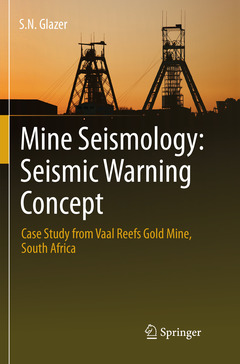Mine Seismology: Seismic Warning Concept, 1st ed. 2018 Case Study from Vaal Reefs Gold Mine, South Africa
Auteur : Glazer S.N.

Stefan Glazer?s book (?) addresses in a very comprehensive manner both technical and practical problems of implementing and then effectively using microseismic networks and data. (?) Stefan proves that through comprehensive microseismic data analysis the location of potential rock burst can be assessed and then prevention action plans can be developed, providing more confidence to management and workers that deposit[s] can be mine[d] safely.
Michal Stawski, VP Strategic Geomechanical Specialist, PT Freeport Indonesia
I began reading this story expecting to find a technical review of the science of seismology and its application in mining, [but] this book is much more than that. (?) This is a must-read for those managing seismically active mines and should provide a wake-up call to the industry as the complex morality surrounding the management of seismic risk needs to be clarified in order for this to advance.
Eric Strom, Director Underground Mining, New Gold Inc.
As a mining geotechnical practitioner having experience in large open pit and underground massive mining operations, I have learned that mining induced seismicity can have a significant impact on the safety and economics of operations. However, seismicity is a complex field that is generally left to specialists with little input from geotechnical engineers and engineering geologists. (?) This is a must read for mine seismologists, geotechnical practitioners and mining engineers alike, and will be a welcome and much needed addition to my own book cabinet. This will be [an] invaluable work as our industry progresses to the mining of new depths in both the underground and open pit environments.
Desmond Mossop Pr.Sci.Nat., Principal Engineering Geologist, SRK Consulting
Date de parution : 08-2018
Ouvrage de 201 p.
15.5x23.5 cm
Date de parution : 10-2017
Ouvrage de 201 p.
15.5x23.5 cm



